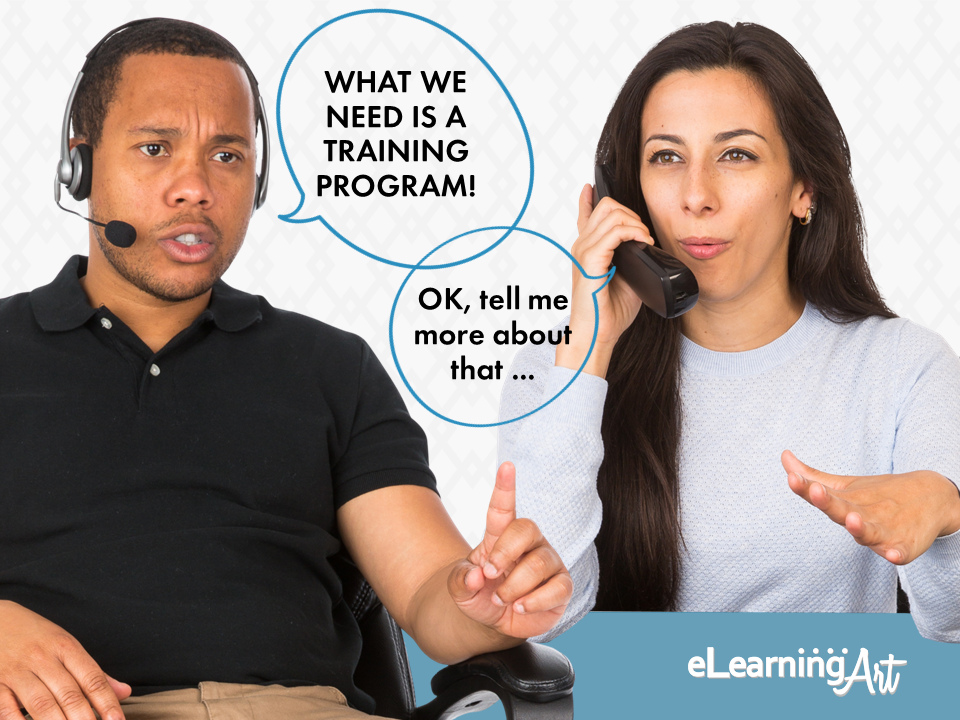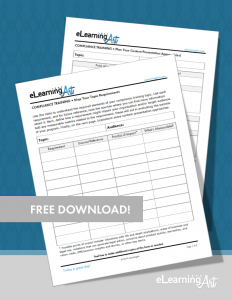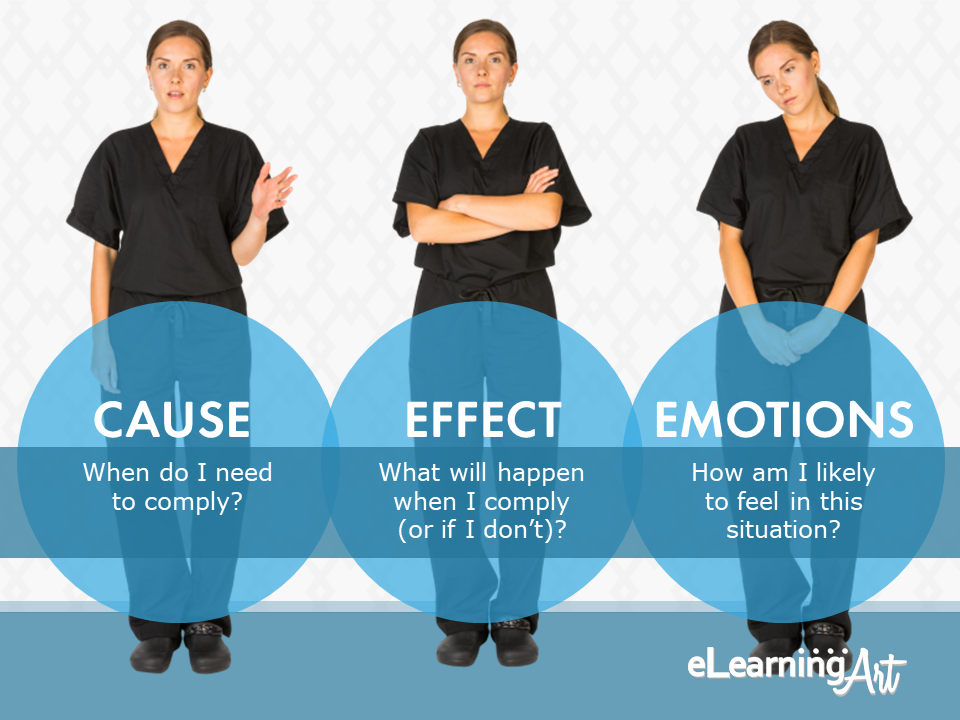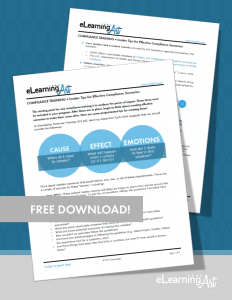 Compliance. It’s everyone’s groan and moan workplace learning, but does it have to be?
Compliance. It’s everyone’s groan and moan workplace learning, but does it have to be?
In fact, compliance topics can be interesting, compelling, and critical — a kind of critical mass that can make them fun for us developers and thought-provoking and relevant for our learners.
Like I said in the Importance of Compliance Training article, when it comes to compliance training, we can produce learning that’s among the most important we will ever deliver.
But …
How do you create compliance training anyway?
In this second post of the compliance training series, I want to offer a framework for getting from “We need a training program for [insert compliance topic]” to a completed program that gets the results your organization is counting on.
We’ll cover these steps to building compliance training:
- Determine whether compliance training is required
- Understand the requirements and gather resources
- Map the points of impact
- Create effective and engaging compliance training solutions
- Gain insight on training effectiveness
Step One: Determine whether compliance training is required
So, you’ve just heard those magic words from someone with enough power and clout to make it happen:
“We need a training program for [insert compliance topic]!”
After a justifiable internal gulp, I suggest your next words should be a respectful “Tell me more about that.”
Here’s the key: Listen carefully to what is said next. You want to hear the details about this request so you can:
- Gain insight on exactly what is being visualized and why it’s considered important.
- Determine the intended audience and the scope of the subject matter to be covered.
- Learn the compelling reasons for the request.
One important reason to have a deeper conversation about the project is to avoid trying to solve the wrong problem.
In some cases, a stated need for compliance training can be a veiled effort to solve a performance or process problem.
For example, issues with “doing things the right way” may be universal (applicable to all employees), or particular (limited to a small group only). Ask about the number of people who are out of compliance, the situations where compliance is challenging, and other defining and refining questions.
If the group of those who need more insight on compliance is small, it may be more cost- and time-effective to consider performance support solutions instead.
This is the time to make this important inquiry, well before the project gets into full swing.
Step Two: Understand the requirements and gather resources
As a result of the questions you ask, you may learn that training associates in the compliance topic is legally required, making it must-have training.
If that’s the case, your own understanding of the requirements and their points of impact on your organization, management, and associates will be critical to every step going forward.
But there’s some good news here! You can apply my motto:
“If there’s someone with requirements, they’ll usually tell you what they require.”
My go-to first stop in any compliance training project is the website for the regulating agency that issued the requirements.
First, I do a search to find out the federal, state, or local regulating agency (or agencies) involved. Then, I visit all applicable websites.
Once there, I look around to see what I can find, and more often than not, I’m rewarded with useful guides and information that gets me moving down the track toward grokking the subject..
Here’s a handful of examples:
- Medical Information Privacy: Regulated by US Health and Human Services (HHS)
https://www.hhs.gov/hipaa/for-professionals/index.html (Click the “Training” tab.)
- Workplace Safety: Regulated by US Department of Labor, Occupational Health and Safety Administration (OSHA)
https://www.osha.gov/dte/training_policy.html (Click the “Training Requirements in OSHA Standards” link to view the PDF.)
- Employment Discrimination: Regulated by US Equal Employment Opportunity Commission (EEOC)
https://www.eeoc.gov/employers/smallbusiness/resources.cfm (Start here, and explore the website.)
Occasionally, your research may turn up some real gems. Look out for items like these:
- Inspector’s manuals that outline what a regulatory inspector will be looking out for. (You’ll definitely want to train those items!)
- Public-facing videos, informational brochures, and how-to manuals. (These can provide insight on best practices for presenting the information, and are often part of the public domain = free content!)
- Case studies. (True-to-life stories you can use to amp up key takeaways.)
- Graphic assets. (Photos, charts, diagrams, and other items that can be used directly or employed as creative idea generators.)
The more you learn and collect about the subject, the more effectively you can search it, so dig in and become a “mini-subject matter expert (SME).” It can only help, and the time spent now will speed development later.
Of course, you may also have access to internal or external SMEs. These people can help you define what must be trained. They will often also tell some useful stories that point to the spots where the requirements are especially important—or especially problematic—for your organization.
As you’re grabbing these topics, I suggest that you drop them into a simple requirements map. For your convenience, I’ve created one for you. Download this document to use directly or as a model for a spreadsheet, shared Google doc, or whatever will best suit your project!
You can see that by using this method, you’ll be creating a one-stop location for top-level thinking about your program. Mapping like this is a good approach for moving from “Where do I even begin?” to “OK, I’ve got this!”
Next, let’s talk about why that “points of impact” column is so important.
Step Three: Map the points of impact
But first, in the mood to watch a quick but enlightening video?
Ray Jimenez of Vignettes Learning loves compliance courses (even “sexy,” haha), and gives us some very actionable advice about building them. Worth the watch, but I’ll give you the gist of what he says here.
In spite of his love for compliance training, Ray takes exception to the read-and-click approach to delivering required compliance material, even when it’s been valiantly dressed-up with animations, interactions, games, and quizzes. The issue?
The compliance program becomes big, bigger, and too big.
Instead, he suggests, zoom-in on the areas of the content that have a business impact. Examples he gives include:
- Situations with life and death implications
- Areas of business and legal risk
- Things that can generate legal action
- Concerns about product quality, warranties, and return rates
To this list, I’d add any insights already gathered from the conversation with the project sponsor and SMEs, and from my own research. In fact, if there seems to be a lot of impact items floating around, I’d do a big messy brainstorm mapping to capture as many points of impact as possible, then see how these sort out against my requirements map.
A blank brainstorm form is included with the downloadable I mentioned earlier.
With that work done, we’re ready to move away from read-and-click toward engaging compliance training. That’s the next step.
Step Four: Creating effective and engaging compliance training solutions
Of course, to create any training solution, we’re talking about a fairly intricate and time-consuming project. Your mapping will help move things toward the down-in-the-weeds next steps of scripting and development, but first, let’s talk about the big structure of your training program.
Instead of dragging the viewer through the whole big stack of compliance-related material, why not create smaller, focused scenarios and introductory lessons built around the points of impact areas. These, in turn, link to the supporting content, including the legal citations, regulatory definitions, procedures, and steps related to compliance.
I call this the “pull” approach.
Instead of pushing all of the details onto the learner, we allow him or her to make a choice to take in the material. In pulling the material that interests them, they fill learning gaps as they see fit. This increases relevancy while reducing overwhelm. Win. Win.
There is another way in which this approach makes sense from an instructional design perspective, too.
You’ll recall from the Importance of Compliance Training article that most compliance training results in learning at the “Remember” and “Understand” levels. Then we expect participants to use that knowledge for applying, analyzing, evaluating, and solving their day-to-day compliance-related realities.
In fact, when we train compliance topics, we’re really hoping that our associates will take in some facts and figures, rules and regulations, then use them as a set of principles and guidelines that will guide them faithfully toward compliant decision-making.
Ruth Clark, in her classic book Developing Technical Training (3rd edition), suggests that this type of training objective requires that we:
- Provide examples of cause, highlighting instances when the compliance behavior would be applicable.
- Provide examples of effect, showing the outcomes of applying (or failing to apply) compliance guidelines.
- Provide a sense of feeling, illustrating the emotions that may be present when someone faces a compliance-related decision.
Looking at this list, you can see how the approach I’ve outlined here allows you to access, illustrate, and showcase the softer, more human, aspects of compliance — the stuff that’s actually in play when a person faces a “compliance moment.”. Scenarios and stories are a great vehicle for accomplishing this.
To help you out with this, I’ve created a list of insider tips for tracking down the stories that will build your learning program for you! You can grab that right here.
With your scenarios and stories in place, map and link the supporting content. The whole package is now in place and ready for development.
We won’t take time with the details of that right here, but I encourage you to make the most of the resources offered here on the eLearningArt blog, and the graphic assets you’ll find in the membership library. These are both designed to make your job as a workplace learning person easier.
For now, let’s complete our high-level how-to steps, by taking a look at what happens after we’ve completed and delivered our compliance course.
Step Five: Gain insight on training effectiveness
Many workplace learning programs that we develop are pushed away from the dock and left to float, forgotten, on an LMS, a website, or as a presentation people attended a time ago.
It’s a sad truth that as developers, we often don’t know whether the workplace learning we complete and deliver is actually effective or not. Without this info, we can’t benefit from a feedback loop that would help us build better learning.
That’s bad enough, but a lack of back-end follow-through for compliance training programs that meet a regulatory requirement can activate some compliance issues of its own.
For example, OSHA makes the following statement in its “Training Requirements in OSHA Standards” document:
“It is a good idea to keep a record of all safety and health training. Documentation can also supply an answer to one of the first questions an incident investigator will ask: ‘Did the employee receive adequate training to do the job?’”
To track the results of compliance training, think in terms of both measures (direct and quantifiable outcomes that tie to actual performance levels) and indicators (indirect results that may signal changes in compliance rates). Setting these in advance of delivering the learning program allows benchmarking by locking-in the all-important “before” piece of the before-and-after comparison. Examples of things you could track include:
- The number of reported non-compliance incidents
- Amounts paid in fines and penalties
- Associate awareness of the compliance requirements
- Associate self-reporting of compliance commitment
Going the full distance with this kind of evaluation requires organizational buy-in. Participation of departments across your organization will likely be needed, and even if that participation is just to provide data points, resistance can occur. If you find that your organization isn’t fully invested in learning whether a compliance training program is working or not, using the empirical methods I’ve just listed may be tricky.
The good news is that you can still employ some informal, qualitative approaches to gather this important for yourself. These include:
- Anecdotal evidence: Make a point of chatting with people who’ve completed the training. Be bold about asking open-ended questions to learn more about the program’s effectiveness in changing their approach to the compliance topic.
- SME follow-up: Go back to your original information sources and ask them if they’re seeing changes in people’s approaches to compliance.
- Surveys: Develop and distribute a quick survey asking for feedback on the program. You can link an end-of-course survey to the program itself, or plan a follow-up survey some period of time after the training period.
- Focus groups: Invite a diverse group of people who’ve completed the training to sit down and talk about it in a facilitated meetup. (If you can swing it, consider offering lunch to encourage participation. Free food!)
By implementing quantitative, qualitative, or both methods to gather insight on your compliance training program’s effectiveness, you can be assured of acquiring new perspectives on what works and what does not.
The great (and, OK, sometimes daunting) thing about compliance training is that there is always more to do. Each insight you acquire in this last step will make the next program that much better. Crafty you!
Let’s Bring This Full Circle
You may recall something I said Importance of Compliance Training article. I’ll paraphrase here:
Your organization is depending on you to help its associates learn—and practice—the rules, regulations, and the guidelines that keep your organization:
- Within bounds of the law,
- In conformance with standards, and,
- Out of harm’s way.
Compliance training is serious stuff with real implications.
Out of everything I’ve written here, I want to make sure you take away one important thought:
Just because it is serious, compliance training doesn’t have to be delivered in a sleep-inducing, wordy, or legalistic way.
It’s a little bold, I know, but challenge yourself to achieve a higher standard, one that focuses on giving associates the information, tools, and decision-making experience they need to face the real world in which they operate.
I’ve given you some great tools here. Employ them to make your job easier, and your organization more compliant.
And have fun learning, before, during, and after each compliance training project!

 Compliance. It’s everyone’s groan and moan workplace learning, but does it have to be?
Compliance. It’s everyone’s groan and moan workplace learning, but does it have to be?








